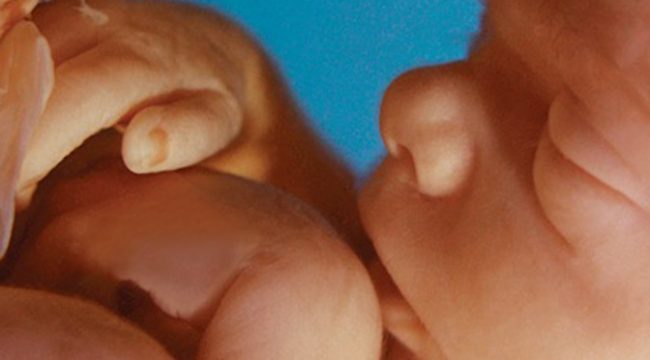In the past, many late-term abortions were committed by injecting a caustic saline solution into a woman’s uterus. This solution burned the preborn baby’s skin and poisoned her. Then the woman would go through labor and “give birth” to a dead baby.
Today, most late-term abortions are committed by D&E. In a D&E, the baby is dismembered while alive, extracted piece by piece. Watch as former abortionist Dr. Anthony Levatino illustrates this procedure in the video below.
Sometimes saline abortions failed, and babies were born alive. This was shockingly common, but usually such cases were covered up and hidden from the public. According to an article in the Philadelphia Inquirer in 1981:
[F]or every case that does become known, 100 probably go unreported. Dr. Willard Cates, an expert on medical statistics who is chief of abortion surveillance for the Centers for Disease Control in Atlanta, estimates that 400 to 500 abortion live births occur every year in the United States… literally an everyday occurrence.
They are little-known because organized medicine, from fear of public clamor and legal action, treats them more as an embarrassment to be hushed up than a problem to be solved. “It’s like turning yourself in to the IRS for an audit,” Cates said. “What is there to gain? The tendency is not to report because there are only negative incentives.”1
The article cited a study which found that 10% of aborted babies in one abortion facility showed signs of life.
Covering the same story, a reporter for the New York Times wrote:
Told about the subject of this article, many doctors declined to return telephone calls. In one case, the director of obstetrics at a major New York hospital spoke in detail of an aborted infant’s survival last year and the traumatic impact this event had on the hospital’s staff. The next day, he called back to deny the incident had ever occurred.
Dr. Warren Pearse, then executive director of the American College of Obstetrics and Gynecology, was asked what abortionists did to check whether the baby was alive after an abortion. He said:
You assume the infant is dead unless it shows signs of life. You are dealing with a dead fetus unless there is sustained cardiac action or sustained respiration – it’s not enough if there’s a single heartbeat or an occasional gasp.2
READ: Abortionist at undercover investigators’ hearing: ‘No question’ babies are born alive
While there were rare instances when babies born alive after saline abortions were given medical care and survived (for example, Gianna Jessen and Melissa Ohden, who are now outspoken pro-lifers), most babies born this way were left to die or even deliberately killed outside the womb. We know of some instances because nurses have come forward. One nurse who worked in a hospital where abortions were committed told a reporter:
I saw a bassinet outside the nursery. There was a baby in this bassinet – a crying, perfectly formed baby – but there was a difference in this child. She had been scalded. She was the child of a saline abortion.
This little girl looked as if she had been put in a pot of boiling water. No doctor, no nurse, no parent to comfort this hurt, burned child. She was left alone to die in pain. They wouldn’t let her inside the nursery – they didn’t even bother to cover her.
I was ashamed of my profession that night! It’s hard to believe this can happen in our modern hospital, but it does. It happens all the time. I thought a hospital was a place to heal the sick – not a place to kill.
I asked a nurse from another hospital what they do with their babies who are aborted by saline. Unlike the hospital where I work, where the baby was left alone struggling for breath, their hospital puts the infant in a bucket and puts the lid on. Suffocation! Death by suffocation!3
The Journal of Clinical Ethics shared another story that occurred in a hospital where abortions were committed:
[O]ne nurse told of contacting a physician for advice the first time she delivered a live [aborted] baby. … The physician simply told her to “drop it into the saline solution.” Ethically this was not an option for her. She said, “These babies are human beings that deserve to be treated with dignity and caring.” What she did was clean and dress the baby and carry him around with her until he stopped breathing. She then took him to his parents.4
Botched abortions resulting in living babies were common in the 1970s and 80s. Dismemberment is the preferred method of killing these babies today, which leads to fewer abortion survivors — but according to the CDC, infants are born alive during abortion procedures today, and the number is still likely underreported.
-
Liz Jeffries and Rick Edmonds, “Abortion: The Dreaded Complication.” The Philadelphia Inquirer, August 2, 1981
-
Ibid.
-
D Conklin “Nurse to Senate: “Ashamed of Profession” The Miami Voice, May 25, 1979
-
Elisabeth Boetzkes, et al. “Secrecy, Integrity, Agency: Nurses and Genetic Terminations” The Journal of Clinical Ethics, 13 (2), 2002, 126
“Like” Live Action News on Facebook for more pro-life news and commentary!







